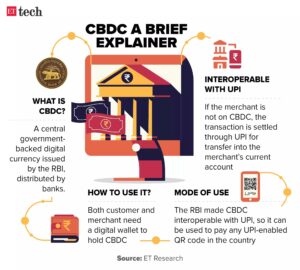
The Reserve Bank of India (RBI) is in advanced discussions with multiple nations to expand its cross-border payment platform and establish seamless payment linkages across Asia.
According to Bloomberg, this integration is expected to enhance transaction efficiency, simplifying international trade and financial activities for individuals and businesses while ensuring a secure and regulated environment.
As part of the initiative, India will be partnering with neighboring countries like Sri Lanka, Bhutan and Nepal. Meanwhile, country’s efforts to establish similar arrangements with other Asian countries, including the UAE, conitnues.
The Reserve Bank of India (RBI) plans to expand its instant cross-border payments platform by including partners from Asia, the Middle East, and the UAE.
Current agreements cover Sri Lanka, Bhutan, and Nepal. pic.twitter.com/K1xmwmHK3G
— Neel (Crypto Jargon) (@Crypto_Jargon) November 24, 2024
The effort is reportedly part of India’s broader strategy to improve the speed, accessibility, and security of international transactions.
EXPLORE: India May Grant Clearance to Two More Offshore Crypto Exchanges for Operations
Expanding Digital Payment Networks In Asia And Beyond
Speaking at a conference in the Philippines, RBI Deputy Governor T. Rabi Sankar emphasized on India’s existing arrangement with Sri Lanka. There are ongoing discussions with other neighboring countries including the UAE to extend its payment network and enhance regional financial integration.
Currently, the existing platform facilitates efficient cross-border transactions within South Asia. With the UAE’s inclusion the RBI seeks to widen influence in the Middle East.
However, the initiative will not be limited to traditional payment systems alone. The RBI is actively exploring to integrate central bank digital currencies (CBDCs) for cross-border settlements.

Highlighting on India’s commitment to build standards for cross-border payments using CBDCs, RBI Governor Shaktikanta Das had stated earlier that digital currencies can provide cost-effective solutions for remittances, trade, and financial transactions.
The RBI’s focus on creating a “plug-and-play” model for CBDCs is essentially aimed at positioning India as a global leader in digital payment solutions.
EXPLORE: RBI Governor Reaffirms Support For CBDC In India For Cross-Border Payments
Indian Authorities Continue Resisting Crypto
The RBI has always maintained a cautious approach toward cryptocurrencies, citing concerns about investor protection, market integrity, and potential misuse.
In April 2018, the RBI had issued a circular prohibiting regulated entities, including banks, from providing services to cryptocurrency-related businesses.
In March 2020, the Supreme Court of India overturned this directive, ruling it unconstitutional. The court’s decision effectively allowed banks to resume services for cryptocurrency exchanges and users.
Despite the Supreme Court’s ruling, the RBI has continued to express apprehensions about cryptocurrencies. It has repeatedly issued public notices highlighting risks associated with price volatility, lack of regulatory oversight, and potential misuse for illicit activities such as money laundering.
The central bank has conducted studies and pilot projects to evaluate the feasibility of a digital rupee, aiming to leverage blockchain’s advantages for secure and efficient transactions, exploring the potential of blockchain technology and CBDCs.
Moreover, with a focus on safeguarding market participants while addressing cybersecurity and systemic risk, RBI plans to foster innovation in digital financial systems while maintaining strict oversight of private cryptocurrencies.
EXPLORE: Who Is Chirag Tomar? Indian National Handed Prison Sentence For $20 Million Coinbase Scam
Strengthening Regional Ties with Digital Currency
The RBI’s cross-border payment initiative is aimed at fostering regional partnerships. By integrating Southeast Asian and Middle Eastern countries into its payment network, India seeks to strengthen economic ties and promote financial inclusion.
Furthermore, the RBI is also working on offline solutions to extend digital rupee usage to rural areas with limited connectivity ensuring equitable access to modern financial tools, especially in underbanked regions.
Speaking at the ‘RBI@90 Global Conference’ on 26 August, 2024, Das said “It is important to emphasize that there should not be in any rush to roll out system-wide CBDC before one acquires a comprehensive understanding of its impact on users, on monetary policy, on the financial system and on the economy.”
During the RBI@90 Global Conference, Shri Shaktikanta Das, Governor of the Reserve Bank of India (#RBI), shed light on their #CBDC progress and how they envision #digitalcurrencies will shape the future of their financial ecosystem. Read more
https://t.co/nF31SMPvrp pic.twitter.com/yz9a5g74R5
— Digital Pound Foundation (@digitalpoundfdn) August 26, 2024
RBI’s digital rupee, introduced as part of a pilot program in 2022, is central to its vision of modernized payment systems. Initially focused on bank-to-bank settlements, the digital rupee pilot has since expanded to attract over five million users, as per August 2024 data.
“The programmability feature of CBDC could serve as a key enabler for financial inclusion by ensuring delivery of funds to the targeted user,” Das added.
With no definitive timeline for a nationwide rollout, the RBI’s strategy will include development of an interoperable CBDC framework to facilitate seamless transactions with global systems.
The post Reserve Bank Of India Expands Digital Payment Connectivity To Asia, Middle East appeared first on .



